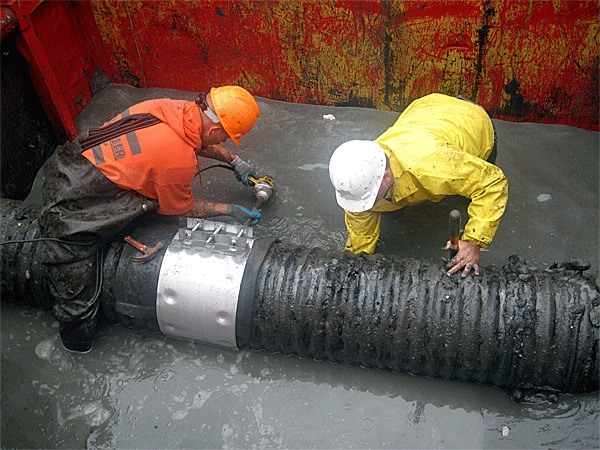A decision to reroute treated effluent to its lagoon facility on the Seaplane Base will solve Oak Harbor’s broken sewer outfall problem but the solution is not without risk, city officials say.
According to Wastewater Operations Manager Steve Bebee, for the time being this is the best and most affordable way of dealing with the problem. However, shuttling the treated effluent to the lagoon site could put the facility in jeopardy of exceeding the concentration limits outlined in its state-issued permit.
“We have parameters that we have to stay within,” Bebee said.
On May 24, an 18-inch outfall from the city’s RBC treatment plant in Windjammer Park failed. The line, which extends about 1,100 feet into Oak Harbor Bay, broke about 290 feet from shore and water could be seen bubbling up from the tide flats.
A small robot fitted with a camera was sent down the line, and except for the break, it appeared to be in good overall condition. However, the City Council authorized $75,000 for an emergency patch job and during the repair it was determined that the pipe was in much worse shape than first thought.
Bebee said the robot only traveled down about 90-feet of the line. It turned out about three-fourths of the outfall, starting from the break, was peppered with softball sized holes.
City staff have been scratching their heads ever since trying to figure out how to address the problem over the long term. While replacing the line seems like the obvious solution, it would be expensive and is complicated by the city’s plans to build a new wastewater treatment plan by 2017. The plant site has yet to be determined.
“To spend a bunch of money on an outfall that may or may not be in that location didn’t make sense,” Bebee said.
The options considered varied widely in cost, from $54,000 for a slip line – essentially a sleeve that fits inside the broken line – to up to $1 million for a brand new larger outfall that could be used with the new facility. But again, without knowing for sure where the new treatment plant will be built all that money could go to waste for what would be a temporary fix.
“Of all the options we looked at, this is probably the most cost effective, and carries the least risk in terms of dollars and cents,” said City Engineer Eric Johnston, in a presentation to City Council members during a recent Public Works Standing Committee meeting.
As for the permit problem, Johnston told the committee it is not an insurmountable obstacle. It’s simply a matter of vigilance. Facility staff will have to constantly monitor the situation to insure that water concentrations stay within the guidelines of the state Department of Ecology issued permit.
While there is a risk that the permit limits could be exceeded, Bebee agreed that the problem is manageable. In the event of a problem, the old outfall could be turned back on for short time until the crisis passes, he said.
What would have been a much larger problem is if the City Council had not authorized a diversion pump upgrade at the RBC plant in 2009. If the pump and generator had not been added, the city could have had no other choice but to accept one of the more expensive solutions, Bebee said.
“Had we not done that, we would have been in a world of hurt,” he said.



